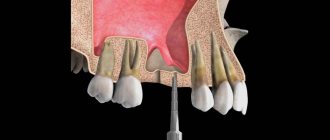Flux on the gums is an extremely unpleasant, but quite common phenomenon, which is an inflammatory process in the periosteum area. The word “flux” is of German origin and is translated as “flow, flow.” Today, this term is not commonly used in professional circles. Instead, experts use the scientific name of the disease - odontogenic periostitis. In most cases, it overtakes the most patient patients who diligently avoid visiting a professional dentist for a long time. As a result, due to laziness or fear of the dentist, the patient receives severe swelling of the gums, constant dull pain, and in some cases, high fever.
Despite the fact that the phenomenon in question cannot be called a rarity, this does not make it any less harmless. The advanced form of periostitis is quite dangerous, so the health of the oral cavity and teeth should be taken as seriously as possible, and at the first signs of inflammation you should consult a specialist as soon as possible.
Causes of the disease
Patients often blame the careless work of dentists for the development of inflammatory processes in the oral cavity. Thus, “flux after wisdom tooth removal” is one of the most discussed topics on dental forums. In fact, the most common causes of periostitis are gum trauma and untreated tooth decay. Often the situation is complicated by the patient’s reluctance to visit the dentist in a timely manner. As a result, food debris inevitably accumulates in places of damage, which eventually begin to rot. Further, the pus accumulates and then begins to rapidly spread, affecting healthy tissues of the oral cavity.
The most common causes of gumboil are damage to the gums, poor oral hygiene and caries.
Treatment of flux on the gums with folk remedies cannot guarantee a high-quality result. Most often, self-prepared medicinal products can only suppress the pronounced manifestations of the disease, and not eliminate the causes of its occurrence. For this reason, when the first symptoms of periostitis appear, it is important to undergo high-quality flux treatment in dentistry, which can guarantee complete relief of the inflammatory process.
Do not heat the inflamed area
When people think about how to treat flux, they usually remember various traditional medicine, in particular compresses and heating (for example, with salt), rinsing with hot herbal decoctions. If you are going to treat flux in this way, then you are making a grave mistake. In 80% of clinical cases, the disease occurs in a purulent form, that is, purulent exudate accumulates in the inflamed periosteum, on which heat has a stimulating effect.
Warming the cheek is contraindicated
If you heat the diseased area, the blood supply to the inflamed tissues will be stronger, and the infection will spread to deeper layers, which will provoke even greater swelling, pain and intoxication of the body. If, under the influence of heat, pus enters the blood or lymph, it can spread to adjacent organs, cause damage to the heart, brain, liver and kidneys, and lead to sepsis (blood poisoning).
It is not forbidden to rinse your mouth with herbal decoctions (chamomile, sage), as they help relieve acute inflammatory processes and reduce pain and swelling. But in this case, the liquid should be slightly warm or at room temperature.
Symptoms of gumboil
Symptoms are expressed in the appearance of a purulent sac or thickening of the gum area. The photo shows a clear example of gumboil on the gum. It is this infiltrate that is the main sign of the development of the disease. Experts distinguish two main forms of periostitis:
- The acute form is accompanied by severe toothache, severe tissue swelling, and swelling of the cheek. As the disease develops in the lower jaw, inflammation of the lymph nodes and swelling of the chin may occur. Often the advanced form of the disease causes elevated body temperature.
- The chronic form of the disease proceeds slowly and imperceptibly, which is its insidiousness. Often there is thickening of the jaw bone in the affected area. Despite the fact that there are practically no pronounced symptoms in this case, the consequences of this form of flux are no less dangerous.
Why does it occur
In order to understand how to remove flux, it is necessary to establish what led to its appearance. If the provoking factor is not eliminated, the disease may return. Among the main reasons for the violation:
- untreated deep caries;
- a large amount of hard plaque extending far under the gum;
- dental root cyst;
- inflammatory lesion of the gingival pocket;
- receiving mechanical injuries;
- general hypothermia of the body (especially against the background of reduced immunity);
- poor oral hygiene.
According to statistics, most often the disease occurs precisely because of advanced caries and pulpitis. If there is a large “hole,” the infection easily penetrates deep into the dental tissues, affects the surrounding structures and causes nerve destruction. Then pulpitis develops.
If left untreated, it will become chronic. The pain will become mild, but this does not mean that the disease has gone away. It’s just that now it’s happening secretly. The infection will continue to destroy the internal structures of the diseased unit. As they die, narcotic masses will begin to be released. To remove them, an abscess forms on the gum. This is flux.
If it is localized on the periosteum of the upper jaw, then the upper lip and the area under the eye swell. If inflammation progresses in the lower jaw, the chin and cheek swell, and the lymph nodes become painful.
Diagnostics
Before proceeding with dental flux treatment, the doctor must conduct an appropriate diagnostic examination. The exact diagnosis is determined based on data obtained during a clinical examination and x-ray diagnosis. Laboratory tests allow you to accurately determine the stage of the inflammatory process. Only after making an accurate diagnosis will a specialist be able to decide what to do with gumboil and which method of treatment in this particular case will be optimal.
How to recognize periostitis?
Adults suffer from flux much more often than children. Note that such inflammation is accompanied by a number of symptoms, so it immediately makes itself felt.
Signs of classic purulent flux:
- the mucous membrane hurts a lot
- soft periodontal tissues become inflamed and swell. The cheek swells on the side of the localization of the pathological process
- lymph nodes increase in size
- body temperature rises to +38 degrees
It is worth understanding that periostitis does not go away on its own. Some patients are sure that after the purulent contents flow out of the burst lump, there is no need to treat the inflammation. They say it went away by itself. However, this is a misconception and in this case a dental clinic will definitely be required. After all, it is possible to completely get rid of pus only by installing a special drainage and carrying out certain therapeutic measures prescribed by the doctor. If flux treatment is started on time and carried out correctly, then the pathology can be eliminated in 12-14 days. If the form is advanced, recovery will take more than a month.
How to treat flux?
If your tooth hurts and gumboil appears on your cheek, you shouldn’t panic and look for something to rinse your mouth with. “Grandmother’s” treatment methods really help get rid of acute pain and relieve some swelling, but they have not yet helped anyone cope with purulent compaction, which is the main danger. How and with what to treat flux? How to remove gumboil in case of gum inflammation? Only a qualified dentist can give detailed answers to these and other questions.
Self-medication with folk remedies will only help dull the pain and relieve swelling a little. Only a qualified dentist can completely remove pus and eliminate the cause of inflammation.
How is flux treated in dentistry? Currently, there are two main methods of treating gumboil on the cheek:
- Opening the pus sac, in which the doctor removes the accumulated pus through a small incision. The procedure is performed under anesthesia. After removing the pus, the specialist installs a drainage at the site of the incision - a special rubber strip that ensures the outflow of pus and prevents the wound from healing ahead of time.
- Cleaning an abscess through a root canal is necessary if the inflammation is a consequence of caries or a crack in the tooth.
Often in advanced stages of the disease there is a need for tooth extraction. Typically, this procedure is carried out when there is deep destruction of the causative tooth or if there is a large infected area between the tooth and the gum. Removal is also used if there is a sufficiently large crack in the tooth that cannot be treated.
Typically, the doctor begins by making an incision into the periosteum or lining of the mouth. The causative tooth is usually removed gradually, that is, in parts. For this, a special dental saw or laser is used. Modern equipment has made it possible to make the procedure for tooth extraction quick and completely painless, so there is no need to be afraid of treatment. After the operation, the sharp edges of the incision are smoothed, which is then washed with peroxide or other antiseptic agents and fixed with sutures.
Content:
- Why does it occur
- Signs
- How it proceeds
- Features of the development of periostitis in children and adults
- What happens if you don't undergo therapy?
- How to remove flux
- How to speed up recovery
- Preventive actions
An inflammatory dental disease that affects the periosteum tissue is called periostitis by dentists.
It is popularly known as flux. It is easy to recognize on your own - a painful abscess forms on the gum, which does not go away for a long time. It is unwise to fight this disease without medical help. When it appears, you should definitely make an appointment at a dental clinic and, during an in-person examination, find out from the doctor how to remove the flux without negative consequences for health.
It is simply impossible to ignore periostitis. It is usually accompanied by acute throbbing pain. Sometimes it can even lead to fever and a sharp decrease in performance. When there is a lot of pus in the “bag”, it bursts. Then the purulent masses flow out, and the symptoms cease to be so bright.
Antibiotics for flux
As noted above, flux is a consequence of a bacterial infection, which is often treated by taking antibiotics. Many, at their own peril and risk, try to cope with inflammation by independently taking quite strong medications that can cause serious damage to the health of the entire body. Effective and at the same time safe treatment of flux with antibiotics can only be prescribed by a qualified specialist.
Antibiotics for flux are prescribed by a doctor individually. Self-use of strong medications is fraught with serious consequences for the entire body.
Antibiotics, like anti-inflammatory drugs, are used in dentistry for flux as part of complex maintenance therapy. The only way to stop the inflammatory process and remove the pus is surgery. Antibiotics are usually prescribed at the very beginning of treatment if the disease is in the earliest stages of its development, but identifying such inflammation at the initial stage can be quite difficult. As a rule, the dentist is able to detect the very first signs of periostitis by accident, for example, during a routine examination of the oral cavity. The specialist prescribes antibiotics for flux individually, depending on the characteristics of the patient’s body and the general clinical picture.
How many days does tooth flux last?
Waiting for the flux to disappear on its own is, to say the least, naive. Some patients believe that if the flux bursts and pus comes out of the wound, then further treatment may not be carried out at all. This is a big mistake, since complete removal of pus requires special drainage, as well as complex therapy and subsequent treatment in the dentist’s chair. With timely and correct treatment, the flux disappears on average in 12-14 days; rehabilitation after severe periostitis can take more than a month.
Flux - treatment in children
If a child has flux, you should never give him medications on your own, and especially antibiotics. Only a dentist can prescribe a medicinal course of treatment. Antibiotics destroy both pathogenic and beneficial bacteria that help fight infection, so the unauthorized use of such serious drugs can lead to negative consequences for the child’s entire body.
Treatment of gumboil largely depends on the causes of its occurrence. So, this process is not much different from the treatment of periostitis in adult patients. As a rule, to begin with, the specialist makes a small incision in the area of the inflammation and ensures the outflow of pus using a special drainage system. The treatment then continues at home under the supervision of parents. Most often, a complex of medications is prescribed, but in some cases, a specialist may allow you to limit yourself to rinsing with special decoctions and solutions.
Compresses and lotions for periostitis
Compresses and lotions have a local anti-inflammatory and disinfecting effect, they destroy pathogenic microbes and will help get rid of swelling on the mucous membrane. You can use the drug Dimexide, which is diluted with water until a concentration of 20-30% is reached. The compress is applied to the area of inflammation and left for about an hour.
Soda lotions also help a lot. Baking soda is diluted in a volume of two teaspoons in 200 ml of water. You can moisten a cotton pad or several layers of gauze with the solution and then apply the lotion to the affected area of the gum.
Good therapeutic effectiveness is also observed when using salt compresses. It is enough to dissolve a couple of teaspoons in 100 ml of warm water. A gauze swab soaked in the solution should be applied to the inflamed area and held between the gum and cheek for at least half an hour.
How not to cause harm?
What to do if flux appears? Some patients mistakenly believe that swelling and severe toothache can be relieved on their own with the help of warming compresses, herbal infusions and other folk remedies. Unfortunately, such health experiments often end very badly. Thus, in order not to inadvertently harm yourself and provoke further development of the disease, the following contraindications should be observed:
- No warming compresses that contribute to the spread of periostitis.
- Never take painkillers less than 3 hours before visiting the dentist. Otherwise, you can significantly complicate the diagnosis process.
- After opening a purulent lesion, you should not take aspirin. It can provoke bleeding, especially since it is completely useless as a pain reliever in this case.
- If your condition has not improved 12 hours after surgery, you should see your doctor again.
Gels and ointments
Ointments are used for topical application. In particular, this is Vishnevsky’s ointment, which stops the development of the purulent process. The birch tar included in its composition increases blood circulation in tissues and accelerates their natural regeneration.
Among modern gels, it is recommended to use the drug Metrogyl Denta, which contains antibacterial components in the form of Chlorhexidine and Metronidazole.
This article is for informational purposes only, please consult your doctor for details! Ask your doctor about contraindications and side effects.
What to do after removal or opening?
After opening the flux, you should not wait for the swelling to disappear immediately. Many patients feel that the flux does not go away after tooth extraction, although this is not the case at all. In some cases, the swelling may increase slightly after the procedure. Approximately on the third day after surgery, the patient should make a dramatic recovery, but the infiltration may remain for quite a long time. Within a few hours after the operation, the toothache in the area of the lesion should disappear and the body temperature should decrease.
Usually the swelling goes away only a few days after opening the purulent focus. Do not be alarmed if the swelling increases slightly after surgery.
The specialist installs a special rubber drainage in the incision, which you should never try to fix yourself. Otherwise, the recommendations are the same as for regular tooth extraction. You should not eat for several hours after the procedure. During the day, try to avoid hard and rough foods, as well as hot drinks. Regarding the use of medications in each individual case, the specialist gives individual recommendations.
Signs
You can understand that periostitis has developed by the following symptoms:
- tooth pain;
- swelling of the gums;
- an abscess at the base of the diseased unit;
- increased pain when pressing on the affected area;
- swelling of the cheek;
- increased body temperature;
- swelling of the lymph nodes.
If these symptoms occur, you should make an appointment with the dentist as soon as possible. In the early stages, the problem can be eliminated quite easily and quickly. Delay is fraught with health-threatening complications.
Treatment prices
The cost of flux treatment largely depends on the severity and severity of the disease, as well as on the method of therapy chosen by the specialist. It is worth noting that modern medicine offers all the possibilities for quick, effective and completely painless elimination of the causes and consequences of periostitis. In addition, the price for flux treatment is influenced by factors such as the level of prestige of the dental clinic, the cost of the equipment and materials used, and the level of qualifications of the practitioners.
Comments
I got gumboil from my wisdom tooth. I don’t want to go to the doctor, because he’ll definitely tell me to remove it?
Andrey (09/02/2020 at 01:23 pm) Reply to comment
- Dear Andrey, you need to take an x-ray to understand how to proceed. If the wisdom tooth grows without disturbances, has passable root canals, and its crown part is not too damaged, then treatment is possible. The main thing here is not to delay seeing a doctor. If the verdict is the removal of such a tooth, then we must remember that it is much more dangerous not to remove it (osteomyelitis may occur), and be prepared for the operation, because there is nothing terrible in it. Today, even the most complex manipulations are carried out under very high-quality anesthesia and do not cause pain, and if the doctor’s recommendations are followed, damaged tissues heal normally and without complications.
Editorial staff of the portal UltraSmile.ru (09/05/2020 at 09:07) Reply to comment
Tell me if there is an abscess on the gum, but it is not painful and it is clear that it will rupture soon. I'm not taking any action yet. Do I need to go to the doctor? Is it possible to just apply something and then rinse out the pus?
Ivan Petrovich (09.23.2020 at 09:09) Reply to comment
Please tell me, my husband’s gumboil has popped up on several of his teeth many times over a long period of time (2 years). He doesn’t want to go to any doctor. Should he have all these teeth removed or is there a chance to save them?
Anastasia (09.23.2020 at 09:32) Reply to comment
Tell me, please, is there a connection between the exacerbation of chronic sinusitis in the autumn and the appearance of gumboil on the upper tooth at the same time? The fact that the upper “fours” are very weak and already filled and there is a pin in one - I think that sinusitis is also to blame. What about flux?
Vitaly (09/23/2020 at 12:53 pm) Reply to comment
Please tell me, are there any means of prevention after flux treatment? It is possible to somehow protect yourself from repeated cases if you have recently undergone treatment, and I know that this has happened to my teeth more than once.
Ira (11/20/2020 at 6:39 pm) Reply to comment
What should I do if I have gumboil? It’s not possible to see a doctor in the next week, since I live far from the city. Are there any methods to at least drown it out, pause it for a while?
Maria (11/20/2020 at 7:08 pm) Reply to comment
A terrible disease, unpleasant. Surely, with a good specialist, the cost of treatment will be high. But is there any kind of prevention to ensure that you never encounter gumboil?
Alena (11/20/2020 at 7:45 pm) Reply to comment
If it hurts, you won’t stay at home for long. Naturally, you will immediately go to the doctor to prescribe at least something anti-inflammatory. A specialist will help solve the problem one way or another. Many people have had this and everyone has gone through similar things.
Sergey (11/20/2020 at 8:10 pm) Reply to comment
We really need your help. A large abscess appeared on my gum, but I’m afraid that they will tell me to remove the tooth. What is the likelihood of such a development? I really don't want to do this. Thank you in advance.
Alena (11/20/2020 at 08:55 pm) Reply to comment
Write your comment Cancel reply
Stages of flux development
initial stage
In its initial form, the flux makes itself felt only minimally. It can be suspected if there is a lump on the gum, as well as slight pain. If detected early, periostitis is treated with conventional anti-inflammatory drugs in combination with painkillers. Conducting an initial examination, the dentist assesses the condition of the tooth root. The question of the appropriateness of treatment is being decided. But, as a rule, at this stage, the tooth can almost always be saved.
Flux: initial stage
Acute stage
If the early stage has passed the patient’s attention, the formation of a purulent sac begins. A dental surgeon makes an incision in the gum. The accumulated pus is removed, followed by treating the cavity with antiseptics. Antibiotics are prescribed. The period of their admission is determined by the attending physician.
Flux: acute stage
Advanced stage
Further lack of treatment is fraught with the penetration of pus into the soft tissues and further into the internal organs of the whole body. This provokes the appearance of phlegmon - a disease that is extremely life-threatening.
Flux: advanced stage
What is the danger of flux?
This pathology is characterized by the development and further damage to deep periodontal tissues. If left untreated, periostitis takes on the most severe forms and leads to infection of the entire body, which can even lead to death. Therefore, it is important to undergo a preventive dental examination and not delay treatment. The doctor will be able to recognize the pathology in time and take measures to prevent the development of inflammation. This will allow you to save your teeth and avoid various complications that gumboil left unattended can cause.











